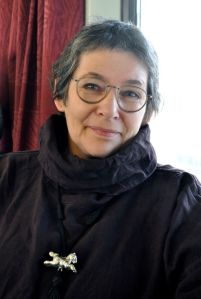Guest Post by Debra E. Sloan
Thomas (Tommy) Kakinuma 1908 – 1982
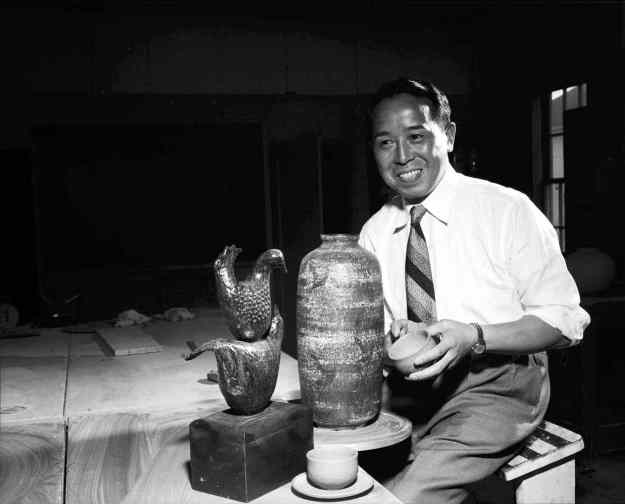
Thomas Kakinuma, UBC, late 50s, Image courtesy of Rare Books and Special Collections, University of British Columbia
Capsule
Dates: 1908 – 1982, Tanuma-shi. Tochigi-Ken, Japan. Thomas Kakinuma was born in Tanuma-Shi, Tochigi-Ken, Japan in 1908 and immigrated to Vancouver, Canada in 1937 and naturalized in 1951. He died in Burnaby BC Sept 9, 1982.
Production dates: approximately 1950 – 1978
Location: Burnaby, British Columbia
Types of Work: Ceramic sculpture, decorative vases, functional ware, small animal figurines, weavings, and painting
Preferred Kiln Type and Firing: electric kiln, cone 6 -8
Preferred Clay: mainly stoneware
Signature/Mark/Chop:
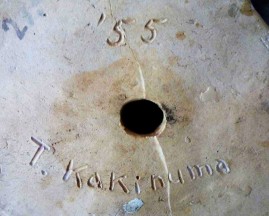
Kakinuma Signature. Incised T. Kakinuma ’55. Courtesy of the author.
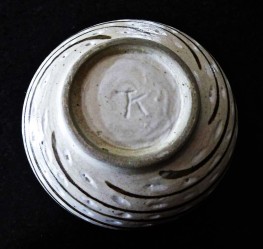
Incised TK mark on trimmed foot of bowl. Courtesy of the author.
Biography
Thomas Kakinuma was a highly regarded mid-century potter and sculptor living and working in the Lower Mainland of British Columbia. Throughout the 1950s and 60s, his ceramic art was celebrated across Canada, and received significant international recognition. Interest waned in his stylized pottery and sculptures by the mid 1970s, as modernism in general fell out of fashion. With the passage of time, and the passing of original owners, Kakinuma’s work has started to resurface, and once again is capturing attention. In our era of intellectualized and dematerialized art practices, it is a great pleasure to encounter art intended to inhabit the personal realm, and art that generates attachment.
Kakinuma was born in 1908, in Tanuma-Shi, Tochigi-Ken, Japan, near Tokyo. As a child he drew extensively, but the political and social unrest in pre-WWII Japan caused his parents to discourage him from pursuing a career.in art. However, Kakinuma did quietly take correspondence courses in painting through the Tokyo Wased University.[1] His interest reflects how, since the 1880s, Western art and technology had captivated the Japanese imagination. In a 2017 conversation Mrs. Kakinuma spoke of how Kakinuma worked in a confectionary shop owned by his relatives in order to finance his departure from Japan, (accounting for his lifelong love of baking.) At the age of 29, in 1937, Kakinuma immigrated to Canada. Vancouver was supposed to be a steppingstone to Paris where he intended to study painting. Once in Vancouver he worked as a domestic servant determined to pursue his dream.
It can only be assumed that Kakinuma would have been caught up in the internment of the Japanese in BC, or the mandatory expulsions starting in 1942, and continuing till 1949. Very little is publicly known about his war-time experience. In a revealing 1969 Vancouver Sun article,[2] in his own words, Kakinuma said,
“When the war came and the evacuation, I lived in Toronto and decided to become an artist.”
What we do know is that Kakinuma persisted with his studies in Toronto, supported by a scholarship awarded in 1946, and in 1947 graduated with Honours from the Ontario College of Art (OCA) in the Fine Arts programme.
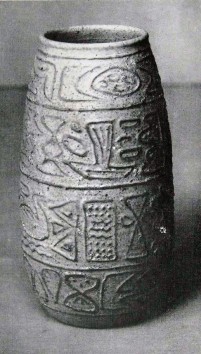
Thomas Kakinuma. Vase, 1955, $50.00 Purchase award. Courtesy of the National Gallery of Canada.
There were a number of factors that have contributed to the regard with which Kakinuma was held during his working life. Foremost would be his work, which received immediate recognition nationally and internationally. His stylized approach reflects mid-century aesthetics and his stoneware sculptures are strongly rendered and abstracted forms that demonstrate an affiliation with, and an understanding of modernism. His pottery is technically competent with clean lines. His handsome vases are often embellished with detail reminiscent of the organic flow of art deco design that had flourished in Japan during Kakinuma’s formative years. However, it is in his animal figures, with their indefinable charm, where Kakinuma’s character is apparent.
Another factor that added interest in Kakinuma’s work was the growing appreciation of Japanese aesthetics post WWII. In Vancouver this appreciation was augmented by the popularity of the Nitobe Memorial Garden, created during the 1930s by landscape architects and gardeners brought in from Japan. The garden honours Inazo Nitobe (1862–1933) whose goal was “to become a bridge across the Pacific.” It was Bertram Charles Binning (know as BC Binning), the pivotal Vancouver artist, and a future friend of Kakinuma, who helped negotiate for the gardens at UBC. Many Vancouverites, experienced traditional tea ceremonies held in the authentic Tea House in the Garden. This interaction contributed to an appreciation of ceramics that embody Japanese aesthetics.
Regard for anything Japanese was also informed by the 1940 A Potter’s Book, by Bernard Leach. The book acted as a cultural lynch pin between East and West, introducing the evocative notion of Mingei, a movement founded in Japan by Yanagi Sōetsu in 1926. Mingei was predicated on the notion on preserving and promoting the dignity and anonymity of folk craft. Interestingly these ideas were rooted in the late-19c British Arts and Crafts movement that quickly spread across America and Europe before emerging in Japan as Mingei. Leach, who was in Japan from 1909 to 1920, is acknowledged as one of the founders.
In Post WWII Vancouver, an emerging understanding of the ideas behind Mingei, as an East/West hybridization, supported interest in Japanese art and culture, and aroused interest in Japanese artists like Kakinuma who had immigrated to Canada.
The final reason for interest in Kakinuma was his compelling story. He was an immigrant artist, shadowed by his undisclosed war time experiences, who resolutely pursued his education across North America. His success pointed to the dawning notion of a benevolent Canada, and acknowledging his art was a way to address the appalling wartime treatment of Canadian citizens of Japanese origin.
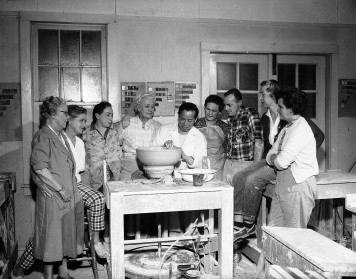
Thomas Kakinuma, centre, with Olea Davis, pearls, and class at UBC, late 50s, Courtesy of Rare Books and Special Collections – University of British Columbia
As mentioned, the Japanese, of whom 75% were Canadian citizens, had been interred or were expelled from British Columbia until April 1 1949. Consequently after graduating in 1947 from the OCA and unable to return to BC, Kakinuma kept moving east, and from 1948–1950 attended the Art Students League in New York. This was the closest he would ever get to Paris. He studied with Yasuo Kuniyoshi, who emphasized appreciation of the beauty of nature, and encouraged Kakinuma to return to his Japanese roots.[3]
Upon his return to Canada, in 1951, Kakinuma became a naturalized Canadian. Fresh from his studies with Kuniyoshi, Kakinuma encountered another key figure who would change the direction of his career. In the 2017 conversation Mrs. Kakinuma spoke of an English woman who was a ceramics instructor at the OCA. This instructor showed Kakinuma her collection of Japanese pottery, and apparently Kakinuma said that was when his interest in ceramics in ceramics was ignited. Coming from Japan, he would have had held the ceramic arts in very high regard, and perhaps he could see that a ceramic practice was a way to work and live as an artist. Later I found a short note in a 1966 VAG bulletin reporting that Kakinuma studied ceramics with a Miss Gladys Montgomery at the OCA for one year.
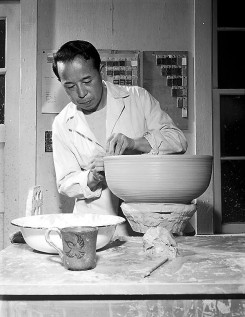
Thomas Kakinuma, UBC, date unknown, Courtesy of the Rare Books and Special Collections UBC
After his studies, Kakinuma finally returned to British Columbia intending to return to Japan. For reasons unknown he was unable to leave Canada. However, he managed to quickly make connections within the Vancouver arts community. In the Post War years Vancouver was essentially a lumber and mining outpost, isolated from the rest of Canada. Kakinuma would have been an intriguing figure who brought exciting influences from ‘back east’ (Ontario and New York) as well his own Japanese sensibilities. It was Bertram Charles (BC) Binning, teaching art at the University of British Columbia (UBC) School of Architecture, who introduced Kakinuma to Olea Davis. Davis ran pottery classes taught by many renowned international ceramicists, through the UBC extension programme, at the legendary Pottery (also known as Army) Huts from the early 1950s until 1969. Kakinuma
continued his studies there, and started teaching at the UBC Pottery Huts from 1955–59, and then from 1965–69.
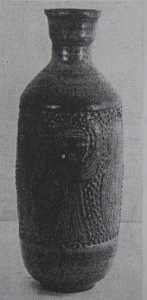
Thomas Kakinuma, Vase, La Ceramique Contemporaire, Ostende, Belgium, July-October 1959. The Clay Products News, Nov 1960, courtesy of Allan Collier.
Kakinuma must have been a very able student, as he was adjudicated into and awarded in the Canadian Ceramics of 1955 exhibition that was jointly organized by the Canadian Handicraft Guild and the Canadian Guild of Potters, and held in the Ontario Museum, of Archeology, Toronto, and then traveled to the Montreal Museum of Fine Arts.[4] His fellow British Columbian artists were Jean Clarke, Olea Davis, Rex Mason, Lenard Osborne, Gordon Stewart and Hilda Ross. Kakinuma received a $50.00 purchase award and Hilda Ross, a $25.00 purchase award. The exhibition catalogue shows a lovely vase by Kakinuma, as seen in his 1959 vase exhibited in La Ceramique Contemporaire, Ostende, Belgium.
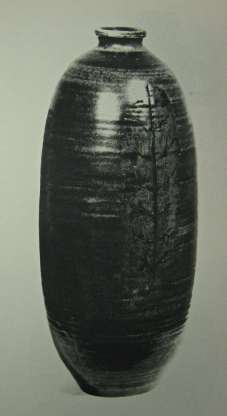
7. Thomas Kakinuma, Vase, 1957. Grand Award Winner, Stoneware, Canadian Pavilion, Brussels World’s Fair, 1958 Image The Clay Products News and Ceramic Record, #4 April 1957.
The Albertan, Luke Lindoe, was also adjudicated into that 1955 exhibition, and perhaps Kakinuma’s success led Lindoe to invite him to teach at the Banff School of Art in 1955/56. Interestingly, in a Vancouver ceramic collection, there is a Kakinuma sculpture of a calf that the collector believes was made in Alberta when Kakniuma was with Lindoe, and is somewhat reminiscent of the style of Joe Fafard’s early cows.
In 1957 Kakinuma won the Grand Award for Stoneware, in the Canadian Ceramics 1957, the second national exhibition of Canadian studio potters. From this exhibition his work was selected for the Canadian Pavilion in the Universal and International 1958 Exhibition in Brussels, Belgium, and remains in the collection. This honour caused him to “shed tears of gratitude for his parents, his native country Japan, and his adopted country Canada.”[5] In 1959 several pieces were selected for the Faenza International Completion of Ceramics, and remain in that collection.
A short article appeared in the Toronto Star, in 1960, during his exhibition at the Laing Gallery,
“[Kakinuma] brings unusual charm and vivacity to his owls and penguins, hens and fish, and if he lacks originality in his forms, he makes up for it with sheer virtuosity. His vases of which there are half dozen or so in the exhibition, can’t be criticized on any grounds I know. They have a classical shape and homespun vigor, and their leaf and twig patterns seem to me to be rendered perfectly.”[6]
Kakinuma’s teaching in 1960 at UBC was interrupted when he was awarded a Senior Fellowship from the Canada Council of the Arts for 1960–61; one of the first Canadian artists to win a Canada Council grant. He spent two months in Mexico, and eight months in Japan, where he studied Satsuma Yaki Ware in Miyazaki-Ken, and he worked in Kagoshima [8]. In an email, the Kakinumas mentioned that he also studied Bizen pottery with Kaneshige Toyo, a “National Living Treasure”, and visited Shōji Hamada, another “National Living Treasure”. It was noted that his work became more polished after attending these residencies. In the Kakinuma’ family collection are some very fine and very rare porcelains, also made during Kakinuma’s residency in Japan.
Kakinuma only stopped teaching at the UBC Pottery Huts when the extension programme was discontinued in 1969. According to the 1969 Vancouver Sun article [7] he had been offered a teaching job in Dublin later that year, however, by then, he was reluctant to leave his adopted home and many friends, and he worried about speaking the “Irish way.” In the same Vancouver Sun article he mentions that he had to work as a designer for a ceramics company in order to support his family, and he went on to say
“In pottery the designs come from painting, the forms from sculpture, and we have to know the study of chemistry.” It is a very complex art. Yet the galleries pick up paintings first, sculpture second and ceramics third”.
However, Kakinuma enjoyed combining all the skills required in a ceramic practice and worked around this persistent bias.
In 1963 he was awarded the silver medal in the International Exhibition of Ceramics in Prague, Czechoslovakia. Despite being such an isolated and nascent ceramic community, some BC ceramicists were receiving remarkable international recognition. Santo Mignosa received the Gold Medal at the Exposition International des Chef d’Oeuvres, de la Ceramique Moderne, at Ostende, Belgium in 1959. Later in the 60s Hilda Ross received a gold medal at the Prague exhibition, and Santo Mignosa’s class from the Kootenay School of Art received the silver medal as the Best Overall School, in the 1966 Faenza International Completion of Ceramics. Also in 1966 Kakinuma and Chizuko Shimana were represented in a two-man exhibition at the Royal Ontario Museum that later travelled, in conjunction with Art Treasures of Japan to the Metropolitan Museum of Art, New York.[9]
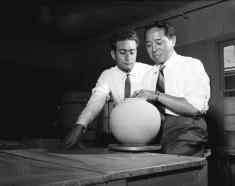
Santo Mignosa and Thomas Kakinuma at UBC, late ’50s. Courtesy of Rare Books and Special Collections, University of British Columbia
While studying in Japan in 1960/61, Kakinuma met his future bride, Ikuko Kawata, a renowned teacher of Japanese classic dance form known as Fujima Ryu Odori. They were married in 1961. Kakinuma was fifty-three years old. As expressed in the Issei, Stories of Japanese Pioneers, “… they were blessed with a daughter and enjoyed a very happy family life.”[8] They lived in Burnaby, where Mrs. Kakinuma and her daughter remained in the family home until 2015.
Close relationships existed within mid-century art circles in Vancouver, encompassing architects, painters, furniture designers, potters, weavers and sculptors. BC Binning founded The Art in Living Group in 1946 that led to the 1954 Design for Living, a seminal exhibition at the Vancouver Art Gallery (VAG) celebrating the fusion of art and living, and where many different mediums and applied arts were represented.
In the 1950s and 60s the Kakinumas had warm family connections with the painters Jessie and BC Binning, who were witnesses at their wedding, Marion and Gordon Smith, Bess and Lawren Harris, and architect Arthur Erickson, exchanging gifts of ceramics and paintings.
Western Homes and Living, ran an article in 1963 about environmental sculpture in the garden and featured Kakinuma, along with Gerhard Glass, Jack Harman, Olea Davis, Ilek Imredy, and David Marshall, further demonstrating the inclusion of various media. The article went on to read,
“ Changes in sculpture over the past two–three years has been so radical that it is not an exaggeration to claim that the West, in particular, Vancouver, BC is now on par with, if not a step ahead of Toronto and Montreal in creation of environmental sculpture.”[10]
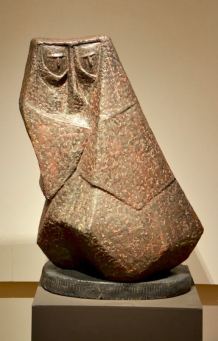
Thomas Kakinuma. Two Nuns in a Storm. Photo: Terry Yip.
As a quirky aside, in the Kamloops Daily News, December 8 2010, [11] there is an article is about the mystery of a lost Kakinuma. The sculpture of a little fisherman was commissioned in the early 1960s for the gardens in front of the Kamloops City Hall, and resided there for almost two decades before vanishing. As it turned out, it was finally resolved that the sculpture had been removed due to an ownership dispute. In the article Kakinuma is referred to a celebrated ceramic artist, and acquiring his sculpture for the city was considered a cultural coup.
During the 1950s the public was intrigued with the novelty of handmade functional crafts, and people began to collect. The Vancouver Art Gallery (VAG) had five group shows of ceramics, and even held pottery demonstrations. The VAG also had four solo exhibitions featuring BC potters Robert Wegsteen in 1961, Thomas Kakinuma in 1962, John Reeve in 1973 and Wayne Ngan in 1979. This interest in ceramics was, for the most part, due to Doris Shadbolt, a curator and Director at the VAG, who was acquiring an understanding of ceramics and had become an active collector. Doris Shadbolt and Grace Cameron, another collector, were also seeking out the best of BC ceramics during the 60s and early 70s for the VAG gift shop. The VAG only had a few Kakinuma’s in their collection until very recently, when a Kakinuma collector bequeathed ten pieces.
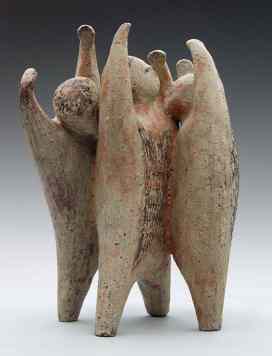
Thomas Kakinuma. Children Playing, 1960, 30.3 x 25.0 x 19.5 cm, Collection of the Vancouver Art Gallery, Purchased with the financial support of the Canada Council for the Arts Acquisition Assistance Program, VAG 61.54, Photo: Trevor Mills, Vancouver Art Gallery
One of them, Children Playing, a particularly fine sculpture, was included in a 1961 exhibition called Small Sculptures organized by VAG to travel around BC, supported by a Canada Arts Council grant. Alan Elder and Ian Thom selected this same piece for the definitive VAG 2004 exhibition Modernism, Art and Design 1945–1960 (British Columbian art and design), and it is featured on a front plate in the subsequent publication. Other than celebrating Gathie Falk’s wonderful ceramics, or including some recent ceramic sculptures in group exhibitions, for the last four decades the VAG, has not demonstrated a curatorial will to learn about the complex ceramic practice, particularly the subtle knowledge required to evaluate the art of pottery. There is hope, however, that the tide has started to turn. Ceramic art works have been included in recent exhibitions, inviting artists who are experimenting with materials such as clay, that impose distinct characteristics and properties.
Along with his celebrated sculptures, and handsome pottery Kakinuma made small rounded animal figurines; sparrows, chickens, seagulls, penguins and owls; as well as fish, monkeys and cats. In my collection is a very unusual and strange hybrid calf and boy sculpture from 1955 made around the time Kakinuma was in Banff.
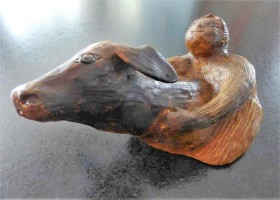
Thomas Kakinuma. Calf and Boy Hybrid, W25cm x H14cm x D14cm, Boy with white slip under iron glaze, 1955. It had been included in a 1955 Northwest Craftsman Exhibition in Seattle Washington. Collection of author.
Kakinuma fashioned his stylized animal forms from thrown or pinched pots, adding modeled and scratched details. There were many other Canadian ceramic artists, whose work he would have been aware of, who were also using stylized animal imagery such as Kjeld and Erica Deichmann; Jean and Stan Clarke; David Lambert, Louise and Adolf Schwenk; Ernst and Alma Lorenzen; Theo and Susan Harlander; and Jarko Zavi to name a few. Kakinuma’s figurines are intimate, animated, and minimalist and could be described as child-like. Some view them as kitsch, but those of us who love them find that something of Kakinuma’s own sweetness seems to inhabit them. It is these figurines that are now resurfacing all over North America and the UK, and are much sought after.
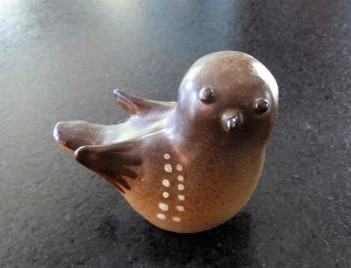
Thomas Kakinuma Sparrow. W10cm x 9cm x 7cm, iron glaze with white slip spots, Collection of author.
The most common is of a bright little sparrow-like bird, sometimes as a singleton, but often fashioned as a circle of birds, and another was a favoured mid-century image, the owl. Kakinuma’s figurines embody a modernist sensibility, and the current interest in mid-century art and furniture may explain their increasing popularity.
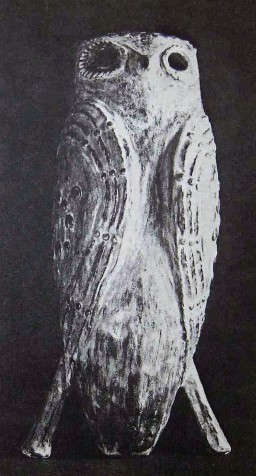
Thomas Kakinuma. Owl, unknown catalogue, Image courtesy of Allan Collier.
One curator likened Kakinuma’s animals to the Haniwa grave sculptures of prehistoric Japan. My thought is that Kakinuma’s figurines relate more, in spirit, to Darumas,(tumbling dolls) traditional Japanese figurines. They may have been a childhood memory for Kakinuma, and though considered a toy, a Daruma is also regarded as a good luck talisman. They are rounded stylized figures, hollow and weighted at the bottom so that they always return to an upright position, an action symbolizing the ability to overcome adversity. Another suggestion is that his figurines may be related to Eto, or junishi, figurines representing the signs of the zodiac, and found in many Japanese homes.
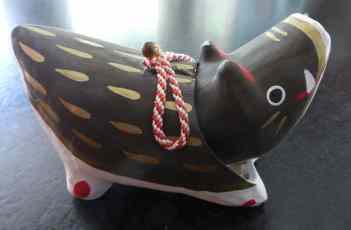
Japanese paper mache, Eto dog figurine with bobble head, W7cm x H 5cm x D4cmMade by a Japanese National Treasure for the 1967 Expo, Gifted to the author by Hiro Urakami.
Kakinuma’s glazing technique was direct. Most pieces were dipped in glaze, and sometimes the surface glaze was decorated using iron slip with simple brush strokes, or dashes of white and blue slip, or very occasionally he slip-trailed designs. He did have a fine red glaze, much sought after, found on some fish, and some lamps and vases.
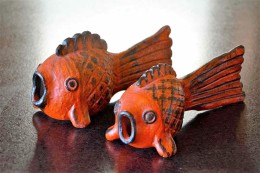
Thomas Kakinuma Red Fish, Large – W24 X H13cm x D8cm, Small – W20cm x H 11cm x 61cm, Red glaze, brushed iron slip, date unknown, Collection of Jasper Sloan Yip and author.
In the 1969 Vancouver Sun article he talked about the complexity of making glaze, and how he could not replicate the specialized ashes and minerals found in Japan.[1] He said that in Canada we all had to make do with our industrialized ingredients. He did not want this comment to be perceived as a complaint, it was simply a fact. Kakinuma worked in stoneware, firing to around cone 6 or 8 (approximately 1220-1250C.) in his electric kiln. While a student at the Ross Hughye School of Pottery, in 1968, I heard other potters saying that Kakinuma was always experimenting with glaze. Later in the 1970s I heard that his health had been affected by working in a poorly ventilated basement studio, a hazard many ceramicists did not take seriously at that time.
Kakinuma’s pottery rarely comes to market, though it is clearly marked and easily identifiable. My impression is that these pieces, particularly his vases, are being kept within the families that originally bought them. His tall cylindrical vases are perfect for large floral arrangements. Kakinuma’s abstract sculptures are even more difficult to find. However, several sculptures turned up at the first retrospective exhibition of Kakinuma’s work, held in January 2018 at the West Vancouver Museum. Some came from gardens, where, as outdoor sculptures, they had resided for the last 40 years. Clearly, they too are being kept and treasured in private collections. Kakinuma’s first love was working as a sculptor and making one-of-a-kind vessels.
Throughout his career, Kakinuma supported his family by teaching and by working as a ceramic designer. He successfully exhibited and marketed his sculptures and pottery. The Quest, run by Bess Fitzgerald, an early supporter of craft in the West, represented his work in shops in Victoria, Vancouver, Calgary and Banff. His work was also available at the Vancouver Art Gallery Shop, thanks to Doris Shadbolt and Grace Cameron. In Ontario the animal figurines sold out, with shop owners complaining that they could not meet the demand. However, during the 1970s it was the animal figurines that were his main source of income, and became his focus. Modernism was slipping out of favour and his sculptures and pottery became perceived as too formal for the home décor of that decade. The organic Leach style of pottery, infused with Asian sensibilities, had become predominant. By 1970 the exhibitions had ceased. In the 1969 Vancouver Sun article, he does rather wistfully say,
“ I really like to work on a one man show, rather than making small items for stores.”[12]
Bob Kingsmill approached Kakinuma, wanting to include him in his 1976 A Catalogue of BC Potters, Kakinuma responded that he was uncomfortable promoting himself, and did not send in his profile.
To live and work as an artist must have been of paramount importance to Kakinuma. He did not differentiate the value of painting to ceramics, except that ceramics were easier to sell. As an immigrant he had successfully integrated into his new society, become a beloved teacher, a respected artist, and supported his family. He was universally and fondly known, as Tommy K. His work was made with earnest integrity and has retained its aesthetic value. All in all, every aspect of Kakinuma’s life was filled with extraordinary accomplishments.
Thomas Kakinuma died September 9, 1982, aged 73, after a lengthy illness. He hated being in the hospital, and his family brought him home for the last few weeks of his life. Doreen Lawson, an Alderman from the City of Burnaby, gave his eulogy. She said,
“Mr. Tommy Kakinuma brought honour to our country and to his community of Burnaby with his work. He leaves a legacy behind – the memory of a warm caring man remains in his sculptures that are a celebration of life and love. He gave of himself to us all, and especially, to his family, he will be sadly missed.”[13]
His family so treasured his memory that Kakinuma’s studio remained undisturbed for the next thirty-three years.
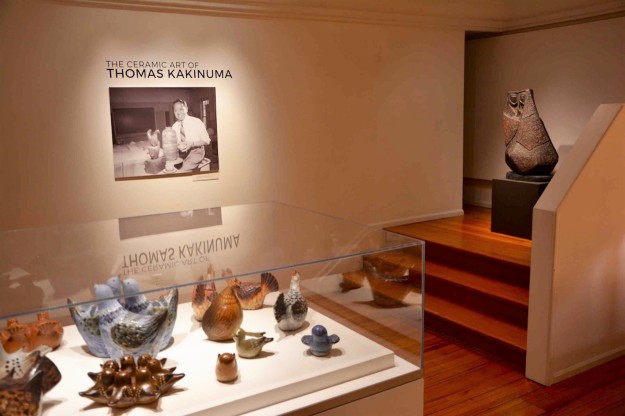
Thomas Kakinuma Exhibition West Vancouver Museum 2018. Photo: Yip
The exhibition The Art of Thomas Kakinuma is the first retrospective exhibit of his work. Held at the West Vancouver Museum, from January 23 to March 10 2018, and curated by Darin Morrison. The exhibition was compiled with the generous assistance of the Kakinuma family. Allan Collier, John Lawrence, Stacy Raynaud, and Debra Sloan. There was a panel discussion Thomas Kakinuma in Context, February 10th 2018 at the West Vancouver Museum with speakers Dr. Carol E.Mayer (curator), Allan Collier (collector, curator), Stacy Renaud (collector) and Debra Evelyn Sloan (ceramicist)
Ken Mayer, donated his photographic skill to record all the pieces in the exhibition and his images can be found in the excellent catalogue made by the West Vancouver Museum. The images of Kakinuma’s work will be kept in the WVM archives.
Copyright, Debra Evelyn Sloan, January 2018
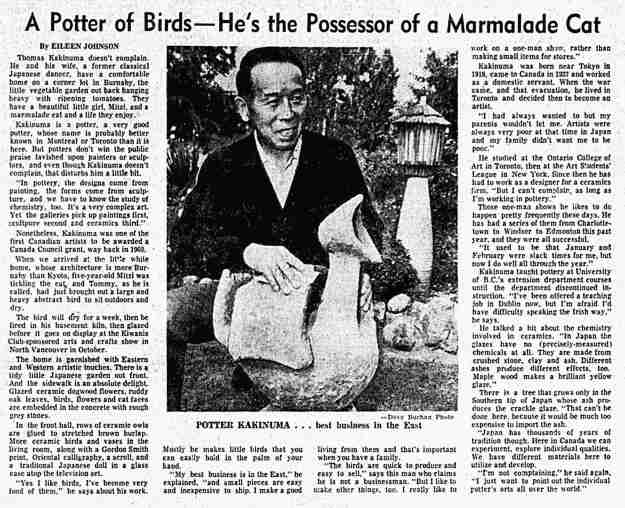
Thomas Kakinuma, Courtesy of National Gallery of Canada Archive and courtesy of the Vancouver Sun, September 8, 1969
A Slide Show of More of Tommy Kakinuma’s Work
Education
- 1944–1947 Ontario College of Art, Toronto
- 1948–1950 Art Students League, New York, NY
- 1950/51 Ontario College of Art, Toronto
- 1952–55 University of British Columbia, Vancouver
Permanent Collections:
- Art Gallery of Windsor, Ontario
- Expo67 Canadian Craft Collection, Confederation Centre Art Gallery, Charlottetown, PEI
- University of Victoria, Fitzgerald Collection, BC
- Vancouver Art Gallery, BC
- Morris and Helen Belkin Art Gallery, UBC, Vancouver, BC
- Museo Internazionale delle Ceramiche, Faenza, Italy
- Museum of Anthropology, UBC, Vancouver, BC
- West Vancouver Museum
Awards
- 1946 Ontario College of Art, Scholarship
- 1955 Purchase Award, “Ceramics of 1955”
- 1957 Grand Award for Stoneware, Canadian Ceramics 57
- 1960–1961 Canada Arts Council Senor Fellowship to study ceramics in Mexico/Japan.
- 1962 Silver Medal International Ceramic Show, Prague, Czechoslovakia
- 1963 Best Ceramic Sculpture, Canadian Ceramics 63
Memorial Award
Langara College, Vancouver awards the Thomas Kakinuma Memorial Award for a 4th term ceramics/sculpture student who is eligible for the Graduating Exhibition, who shows the most promise, and is judged to be outstanding in the area of Ceramics/Sculpture.
Endnotes and References
1 Issei, Stories of Japanese Pioneers, Canadian Local Histories Online- http://ourroots.ca/page.aspx?id=901191&qryID=ec5edf9e-8dd0-49d8-b372-ec38d8988d92 and found in Gordon G. Nakayama, Issei, Stories of Japanese Pioneers, NC Press, 1984
2 Thomas Kakinuma as quoted by Eileen Johnson, “A Potter of Birds—He’s the Possessor of a Marmalade Cat,” National Gallery of Canada Archive and courtesy of the Vancouver Sun, September 8, 1969
3 Issei, Stories of Japanese Pioneers, Canadian Local Histories Online- http://ourroots.ca/page.aspx?id=901191&qryID=ec5edf9e-8dd0-49d8-b372-ec38d8988d92 and found in Gordon G. Nakayama, Issei, Stories of Japanese Pioneers, NC Press, 1984
4 Kakinuma, Thomas, British Columbia 85 Earthenware vase (tall, relief decoration) (awarded $50 Purchase Prize) Earthenware bottle (rutile matt and iron) Sculpture (two chickens] Sculpture (two figures) https://archive.org/details/canadianceramics1955cana
5 Issei, Stories of Japanese Pioneers, Canadian Local Histories Online- http://ourroots.ca/page.aspx?id=901191&qryID=ec5edf9e-8dd0-49d8-b372-ec38d8988d92 and found in Gordon G. Nakayama, Issei, Stories of Japanese Pioneers, NC Press, 1984
6 Toronto Daily Star TO, Ontario, May 21, 1960, National Gallery of Canada Archive. Writer unknown
7 Thomas Kakinuma as quoted by Eileen Johnson, “A Potter of Birds—He’s the Possessor of a Marmalade Cat,” National Gallery of Canada Archive and courtesy of the Vancouver Sun, September 8, 1969
8 Issei, Stories of Japanese Pioneers, Canadian Local Histories Online- http://ourroots.ca/page.aspx?id=901191&qryID=ec5edf9e-8dd0-49d8-b372-ec38d8988d92 and found in Gordon G. Nakayama, Issei, Stories of Japanese Pioneers, NC Press, 1984
9 Potters Guild of BC, Western Potter, #4, March 1966, www.arch-bc.org
10 Art and Architecture In Canada, Loren R Lerner, Mary F Williamson, A bibliography and guide to the Literature to 1981, University of Toronto Press, 1991, ISBN 0 8020 5856-6 – Western Homes and Living 14, November 1963, 12-6, 13 ill. Eng. Sculpture in the Garden, National Gallery of Canada Archive
11 Where is the Tiny Now? http://www.kamloopsnews.ca/news/readers-reporter/where-s-the-tiny-sculpture-now-1.1250428
12 Issei, Stories of Japanese Pioneers, Canadian Local Histories Online- http://ourroots.ca/page.aspx?id=901191&qryID=ec5edf9e-8dd0-49d8-b372-ec38d8988d92 and found in Gordon G. Nakayama, Issei, Stories of Japanese Pioneers, NC Press, 1984
13 Doreen Lawson, Alderman, City of Burnaby, quote, www.arch-bc.org Potters Guild of BC, newsletter 10/82
Resources
- National Gallery of Canada Archive
- Burnaby Art Gallery Archive
- Vancouver Art Gallery Library Archive
- Emily Carr University of Art and Design Archive
- Rare Books and Special Collections, UBC
- Federation of Canadian Artists
- Museum of Anthropology, UBC
- Potters Guild of BC, www.arch-bc.org
- West Vancouver Museum Archive
- The Studio, volumes 153 – 154, P.160
- Collection of Allan Collier, images & catalogues, with thanks
- Conversations with the Kakinuma Family
- The Art of Thomas Kakinuma, catalogue, West Vancouver Museum, ISBN 978-0-9952755-7-7
Images of the Art Of Thomas Kakinuma, courtesy of Terry Yip, Vancouver.
———————————————–
Debra Evelyn Sloan
From 1973–79 Debra took part in a self-directed apprenticeship at Peg’s Place Pottery School in Vancouver. From 1979–82 she attended the Vancouver School of Art, and in 2004 undertook her BFA at Emily Carr University of Art and Design. She has adjudicated, taught extensively, and presented at symposiums. Her work has been exhibited regionally, nationally, and internationally, and is represented in six LARK 500 publications, and at SOFA Chicago 2014–17. She has written for local, national and international publications, and is the first sculptor, as artist in residence and teacher, at the Leach Pottery, St. Ives, since it’s founding in 1920. She has attended international residencies, assisted with scholarships from FUSION, Ontario, and Circle Craft, Vancouver, and was awarded a B.C. Arts Council grant in visual art, 2010. In 2015 she was the recipient of the Hilde Gerson Award, Craft Council of BC, Vancouver Mayor’s Arts Award. In 2018 she will be teaching clay sculpture at the Leach Pottery, Red Deer College, and MISSA, Metchosin – International Summer School of Art. She has been accepted for a residency in Shigaraki, Japan in 2019. She is married to Terry Yip, and has four stellar adult children.

